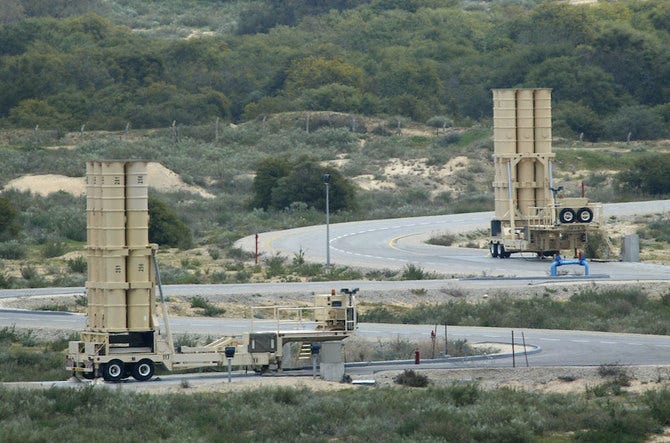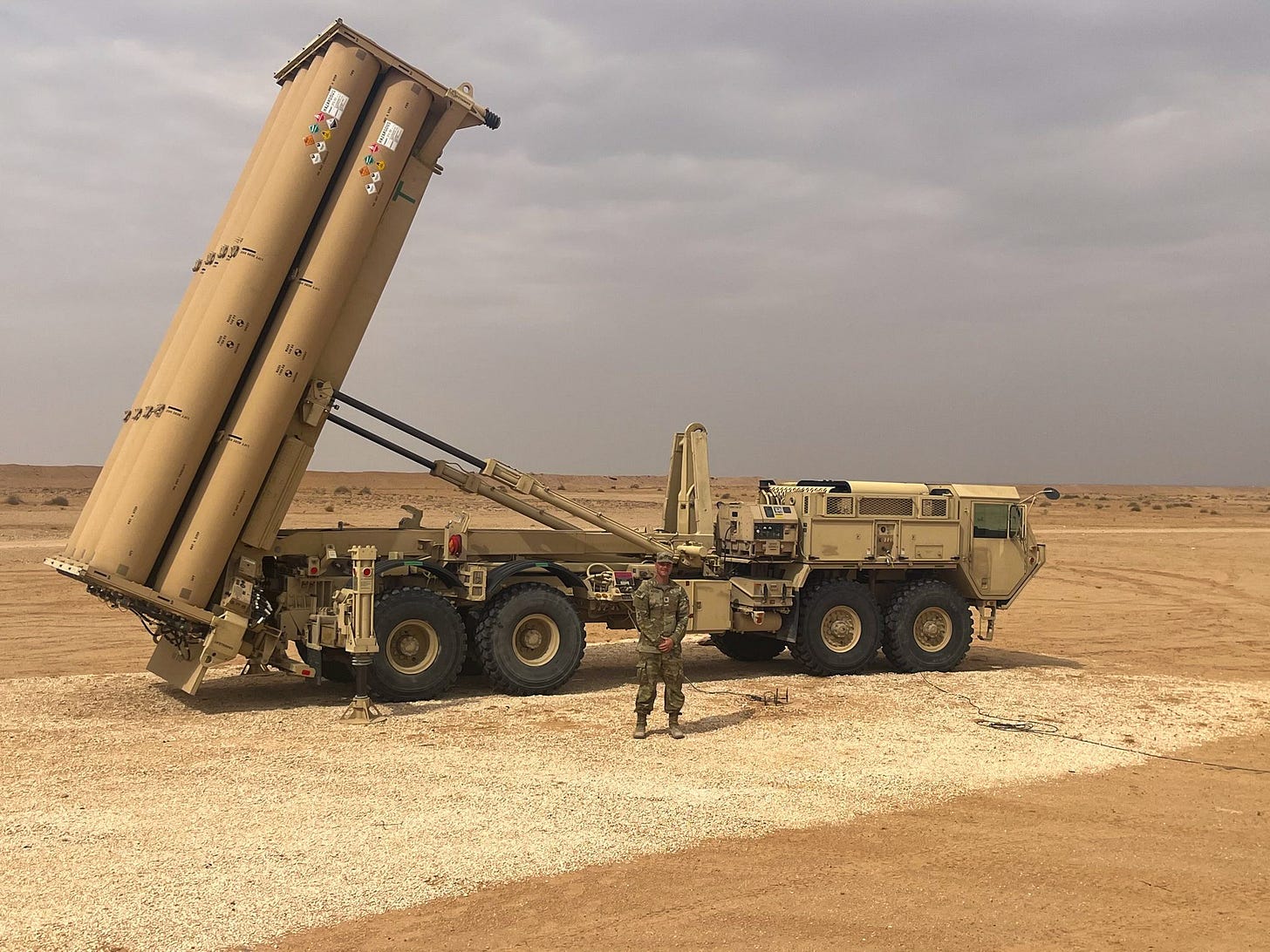The 12 Day Missile War
Tracking interceptions and hits during Iran's ballistic missile strikes on Israel
The genesis of this post was this excellent piece of reporting from researcher Sam Lair at Arms Control Wonk. In this piece, Sam analyses videos posted by a Jordanian photographer who took videos each night of the war that give a great overview of the missile war between Israel and Iran.
I highly recommend reading the whole article and coming back to this one, but if you’re pressed for time or feeling lazy, I’ll do my best to summarize. Essentially, Sam counted in each video posted by Jordanian photographer the number of visible Israeli interceptor missile launches and, based on certain characteristics of each launch, made an educated guess as to what type of interceptor missile it was. The conclusion was that the videos showed a total of 82 interceptor launches, which included 43 Israeli Arrow 2/3 missiles and 39 American THAAD missiles.
Image: Screencap from one of Zaid Abbadi’s videos showing Iranian ballistic missiles descending and Israeli interceptor missiles ascending. Shamelessly ripped from the top of Sam’s article instead of taking my own screencap.
Sam notes that each THAAD missile costs $12.7 million, and each Arrow costs several million each, although the exact amount is unknown. In total, he estimates over $1 billion in interceptor missiles are recorded in these videos, of which $495 million alone is American THAAD missiles. He also notes that the U.S. defense budget for Fiscal Year 2026 only requests the purchase of 32 THAAD missiles, which means that these 12 days of war and 39 recorded THAAD launches burned through more than one year’s worth of THAAD interceptor missiles. While equivalent numbers for the Israeli Arrow missiles are unknown, it is likely (and this is my assumption, not Sam’s) that the situation is similar.
Image: Two Israeli Arrow 3 missile launchers, displaying a total of 12 launch tubes. Israel has 6 known Arrow batteries identified through satellite imagery, each with several launchers like the ones above.
Image: A U.S. Army THAAD launcher, which holds 8 THAAD missiles. A THAAD battery typically has 6 such launch vehicles for a total of 48 missiles available.
Now, on to the caveats. Sam includes (most) of these in his article. Firstly, Zaid Abbadi’s videos did not record every launch of ballistic missiles by Iran against Israel, and the videos do not show every type of interceptor missile used by the U.S. or Israel against Iranian ballistic missiles. As a result, the number of Israeli and American interceptor missiles (and Iranian ballistic missiles) is the absolute baseline. This is the minimum number of missiles that were involved in the war, while the real number may be exponentially higher.
Most relevant for those of us who are U.S. taxpayers, these videos do not show the usage of U.S. Navy SM-3 interceptor missiles fired by U.S. Navy ships stationed off the coast of Israel. The U.S. Navy had five Arleigh-Burke class destroyers armed with the SM-3 missile participate in the war, and while the exact number of SM-3s used has not yet been stated publicly or determined through open-source intelligence, a U.S. Navy admiral stated that the Navy used SM-3s at “an alarming rate.” The SM-3, depending on which version, costs between $10—30 million apiece.
Image: A U.S. Navy Arleigh-Burke destroyer fires an SM-3 missile during a training exercise.
Similarly, no reporting yet exists on how many Israeli short-range interceptors were fired. The missiles described above are, as the THAAD acronym (Terminal High Altitude Area Defense) implies, designed to intercept incoming ballistic missiles at their terminal point (when they are their highest altitude, generally at the upper reaches of the atmosphere or in space). This means a big and very sophisticated and thus expensive missile.
Israel has two short-range interceptor missiles, the David’s Sling and Iron Dome Tamir missiles. The David’s Sling is more relevant here, as it was designed for ballistic missile defense, where it uses extreme maneuverability to intercept incoming ballistic missiles as they descend. The Iron Dome Tamir missile is not designed for ballistic missile defense (as I have discussed previously) but some people have claimed some videos from this recent war show Tamir missiles being used as a last-ditch effort to intercept incoming Iranian missiles. I have not done enough deep digging to determine whether this is credible or not. But, crucially, the David’s Sling undoubtedly was used extensively during this war— and it is a complete unknown how many of these missile types were used. They are also cheaper than the Arrow, THAAD, or SM-3— I have seen claims of $1 million per missile, but nothing concrete (as is typical with Israeli military procurement).
Image: An Israeli David’s Sling Stunner missile is fired from its launcher during a training exercise. David’s Sling launchers typically carry 12 Stunner missiles, and a battery typically carries multiple launchers. Note the slightly off-center nosecone of the missile, which helps make the missile more unstable (and thus more maneuverable) in flight.
Now, let’s get to the other caveat. Zaid Abbadi’s videos did not record every launch, as is stated in Sam’s article. But how many launches were there?
Well, that’s where my investigation comes in. I carried out a fairly cursory search (and thus this should not be considered conclusive) on Twitter to find as many instances as I could of confirmed Iranian missile attacks on Israel during the 12 days of the war.
June 13 (Night launches that lasted through early morning of June 14)
June 14 (Night launches that lasted through early morning of June 15)
June 15 (Night launches that lasted through early morning of June 16)
June 17 (Day and night launches)
June 18 (Night launches)
June 19 (Day launches)
June 20 (Day launches and night launches)
June 21 (Day and night launches)
June 22 (Day launches)
June 23 (Day launches)
June 24 (Day launches)
Now, Zaid’s videos only recorded launch/interception events on June 13/14, June 14/15, June 15/16, June 18, and June 21. Additionally, the videos only recorded nighttime launch/interception events.
Additionally, one thing Sam’s article doesn’t note is how many Iranian ballistic missiles were counted in Zaid’s videos. This is a little more difficult, as this would mostly include missiles that were not intercepted (as the interceptions mostly appear to happen above the field of view of the camera). Additionally, it is tough to tell what flashes of light are actual Iranian ballistic missiles, which are booster sections descending, and which are debris of already-intercepted missiles. However, repeated watches can make it somewhat clear what streaks of light are actual ballistic missiles. Thus, I reached the following numbers from Zaid’s videos:
June 13/14: 42 ballistic missiles
June 14/15: 23 ballistic missiles
June 15/16: 21 ballistic missiles
June 18: 11 ballistic missiles
June 21: 4 ballistic missiles
For a total of 101 missiles— this is, of course, the bare minimum, as I didn’t want to count things that I suspected were booster sections, debris, or something else. Sam counted 82 interceptor missiles (almost all of which carried their mission, success or failure, off-camera).
Times of Israel claims 550 Iranian ballistic missiles were fired at Israel with 31 impacts in “populated areas” (it is not noted how many impacts were in other areas, such as empty fields or military areas). So, if all 82 missiles recorded in those videos intercepted a missile successfully, then those videos theoretically have recorded a total of 183 Iranian missiles, leaving nearly 400 unaccounted for.
It would be irresponsible to speculate about how many THAAD, Arrow, and SM-3 missiles were fired at those unaccounted for ~400 missiles, but let’s do some irresponsible speculating. If 82 Arrow/THAADs were fired for 183 missiles, that’s approximately a 45% Arrow/THAAD launch rate (i.e.. 45 Arrow/THAADs launched per 100 Iranian missiles). If applied to the 550 total missiles allegedly launched, that means roughly 248 Arrow/THAADs were launched in total.
These numbers are, as I said, irresponsible speculation. But, what if…? The 82 recorded alone cost over $1 billion, if indeed 248 were fired then that means $3 billion worth of THAAD and Arrows alone were expended— again not counting SM-3s or David’s Sling Stunner missiles.
While the degree to which Israel and the U.S.’s ability to afford, financially, this rate of interceptor usage is not really in question, their ability to physically supply interceptor missiles at this rate is highly questionable. As mentioned, the U.S. FY2026 budget requests just 32 THAAD missiles be purchased.
It is difficult to determine some things simply based on low-quality cellphone footage of barrages of ballistic missiles, but I will note a few things. First, on June 18th, it was reported that Israel had only “12 days” of interceptor missiles left. Then, June 19th, NBC reported that only 65% of incoming missiles were intercepted as compared to 90% the previous day. A video from June 19th showed at least 17 short-range interceptors launched at a single incoming missile (they failed to intercept it) (also I apologize for sourcing one of the more annoying pro-Iran posters on Twitter).
It is not easy to quantify, but starting around June 19th, the apparent rate of impacts, and the severity of those impacts, increases. There is a video (which I could not find in my relatively brief search today) allegedly shows usage of Iron Dome Tamir missiles being fired at incoming missiles. While none of this is conclusive evidence, it all points in the direction that Israel’s high-tier missile defense of THAAD, Arrow, and SM-3 interceptor missiles were being heavily attrited, and were no longer capable of intercepting incoming Iranian missiles to the same degree they were in the first days of the war.
Did this have an impact on the ceasefire agreement that went into place on June 24? Probably. Was it a decisive factor? Who knows? The story we have gotten from Israeli news and Israel-friendly media in the U.S. is that Iran’s ballistic missile strategy against Israel was a total failure, and that Israel’s missile defense was a stunning success. It certainly is technically very proficient, and the 12 days of this war was the largest demonstration of ballistic missile defense in history.
Yet no Iranian barrage was reportedly larger than approximately 50 missiles, and in total Iran launched only about double what they launched in Operation True Promise 2, on October 1 2024. Additionally, Iran’s missiles are not especially sophisticated. Iran’s development of their missile arsenal has always prioritized affordability and cost-efficiency over technical sophistication— knowing that they would need to fire a lot of missiles to overwhelm and sufficiently damage Israel. Against this Iranian barrage, the U.S. burned through over one year of THAAD missiles. Against this Iranian barrage, the U.S. and Israel deployed the most dense, most sophisticated missile defense array ever assembled. And yet— 12 days of war, no more than ~50 missiles at once, 550 missiles total, and it was stressed to its absolute limit.
Some countries, however, lack Iran’s limitations on funding, and have not been under strict sanctions and arms embargoes like Iran has. Some countries are at the forefront of hypersonic glide vehicle technology and are watching, bemused, as their biggest rival burns through essential missile defense stockpiles in a strategic backwater to no meaningful benefit to themselves.
I’m talking about China, of course.









